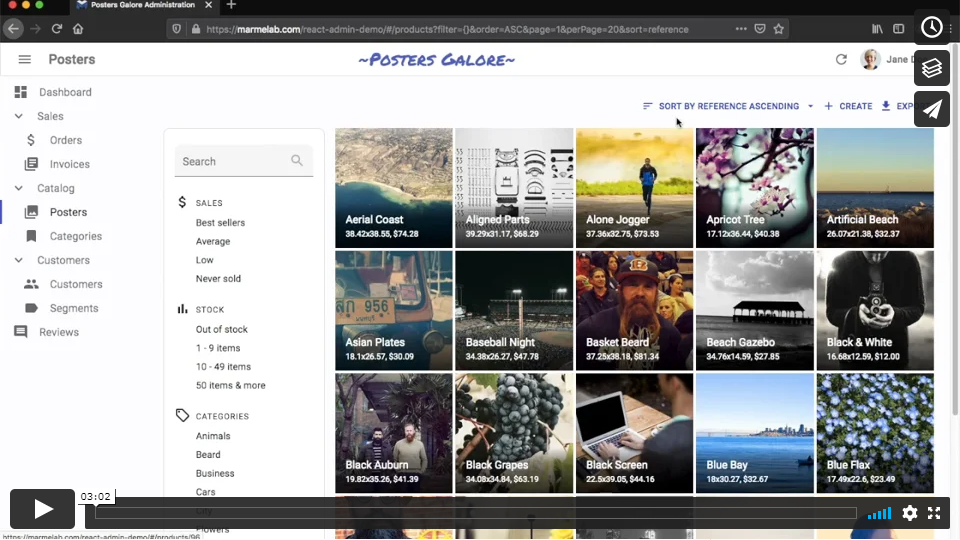JSON Server Data Provider for react-admin, the frontend framework for building admin applications on top of REST/GraphQL services.
npm install --save ra-data-json-serverThis Data Provider fits REST APIs powered by JSON Server, such as JSONPlaceholder.
| Method | API calls |
|---|---|
getList |
GET http://my.api.url/posts?_sort=title&_order=ASC&_start=0&_end=24&title=bar |
getOne |
GET http://my.api.url/posts/123 |
getMany |
GET http://my.api.url/posts?id=123&id=456&id=789 |
getManyReference |
GET http://my.api.url/posts?author_id=345 |
create |
POST http://my.api.url/posts |
update |
PUT http://my.api.url/posts/123 |
updateMany |
PUT http://my.api.url/posts/123, PUT http://my.api.url/posts/456, PUT http://my.api.url/posts/789
|
delete |
DELETE http://my.api.url/posts/123 |
Note: The JSON Server REST Data Provider expects the API to include a X-Total-Count header in the response to getList and getManyReference calls. The value must be the total number of resources in the collection. This allows react-admin to know how many pages of resources there are in total, and build the pagination controls.
X-Total-Count: 319
If your API is on another domain as the JS code, you'll need to whitelist this header with an Access-Control-Expose-Headers CORS header.
Access-Control-Expose-Headers: X-Total-Count
// in src/App.js
import * as React from "react";
import { Admin, Resource } from 'react-admin';
import jsonServerProvider from 'ra-data-json-server';
import { PostList } from './posts';
const App = () => (
<Admin dataProvider={jsonServerProvider('https://jsonplaceholder.typicode.com')}>
<Resource name="posts" list={PostList} />
</Admin>
);
export default App;The provider function accepts an HTTP client function as second argument. By default, they use react-admin's fetchUtils.fetchJson() as HTTP client. It's similar to HTML5 fetch(), except it handles JSON decoding and HTTP error codes automatically.
That means that if you need to add custom headers to your requests, you just need to wrap the fetchJson() call inside your own function:
import { fetchUtils, Admin, Resource } from 'react-admin';
import jsonServerProvider from 'ra-data-json-server';
const httpClient = (url, options = {}) => {
if (!options.headers) {
options.headers = new Headers({ Accept: 'application/json' });
}
// add your own headers here
options.headers.set('X-Custom-Header', 'foobar');
return fetchUtils.fetchJson(url, options);
};
const dataProvider = jsonServerProvider('https://jsonplaceholder.typicode.com', httpClient);
render(
<Admin dataProvider={dataProvider} title="Example Admin">
...
</Admin>,
document.getElementById('root')
);Now all the requests to the REST API will contain the X-Custom-Header: foobar header.
Tip: The most common usage of custom headers is for authentication. fetchJson has built-on support for the Authorization token header:
const httpClient = (url, options = {}) => {
options.user = {
authenticated: true,
token: 'SRTRDFVESGNJYTUKTYTHRG'
};
return fetchUtils.fetchJson(url, options);
};Now all the requests to the REST API will contain the Authorization: SRTRDFVESGNJYTUKTYTHRG header.
ra-data-json-server supports Embedded Relationships. Use the meta.embed query parameter to specify the relationships that you want to embed.
dataProvider.getOne('posts', { id: 1, meta: { embed: 'author' } });
// {
// data: { id: 1, title: 'FooBar', author: { id: 1, name: 'John Doe' } },
// }The name of the embedded resource must be singular for a many-to-one relationship, and plural for a one-to-many relationship.
{ meta: { embed: 'comments' } }
You can leverage this feature in page components to avoid multiple requests to the data provider:
const PostList = () => (
<List queryOptions={{ meta: { embed: 'author' } }}>
<Datagrid>
<TextField source="title" />
<TextField source="author.name" />
</Datagrid>
</List>
);Embedding Relationships is supported in getList, getOne, getMany, and getManyReference queries.
This data provider is licensed under the MIT License, and sponsored by marmelab.

